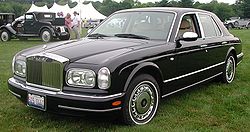Rolls-Royce Silver Seraph
| Rolls Royce | |
|---|---|
| Silver Seraph | |
| Production period: | 1998-2002 |
| Class : | Upper class |
| Body versions : | limousine |
| Engines: |
Otto engine : 5.4 liters (240 kW) |
| Length: | 5390 mm |
| Width: | 1932 mm |
| Height: | 1515 mm |
| Wheelbase : | 3116 mm |
| Empty weight : | 2302 kg |
| Previous model | Rolls-Royce Silver Spirit |
| successor | Rolls-Royce Phantom VII |
The Rolls-Royce Silver Seraph is a sedan of the upper class of Rolls-Royce . It was presented on May 3, 1998 as the successor to the Silver Spirit and Silver Spur series and then launched on the market at the same time as its sister model, Bentley Arnage . After 18 years it was the first completely newly developed Rolls-Royce after the Silver Shadow . A version presented in March 2000 with a wheelbase extended by 25 cm was called Park Ward.
History and technology
All Rolls-Royce Silver Seraph were in the Rolls-Royce factory in England Crewe built. In 2002 production was stopped. BMW had bought the trademark rights from the Vickers group, while the factory went to Volkswagen . The Bentley Arnage was produced in the Crewe factory taken over by Volkswagen until 2009.
As the first Rolls-Royce since the Phantom III from 1936, it is again powered by a V12 engine, which in this case comes from the BMW 750i / iL . The BMW M73 is made of aluminum and provides 240 kW (326 hp) at 5000 min -1 . The maximum torque is 490 Nm at 3900 min -1 . It has an electronically controlled engine management system.
Additional features include an anti-lock braking system for the brakes and Adaptive Ride Control . The Silver Seraph has a ZF five-speed automatic transmission.
The Silver Seraph cost £ 155,175 in Great Britain , $ 220,695 in the United States and DM 444,000 when it was launched in Germany. The torsional stiffness of the body is 65 percent higher than its predecessor. Except for the grille, the rims and the hood ornament, all body parts are identical to the Bentley Arnage. The Silver Seraph also builds on the same platform as the Arnage. The body was available in one-color and two-color paintwork. Furthermore, Rolls-Royce fulfills every individual color combination for the exterior color and interior fittings.
The interior of the Silver Seraph and Arnage are also very similar, but they differ in the details: The Silver Seraph has typical Rolls-Royce style elements, including: a. the center console has more extensive wood paneling. Both vehicles have a leather-clad interior and leather seats. The interior applications on the dashboard, center console, the sides of the front seats and on the door panels were freely selectable. Burr walnut was used as standard.
The Silver Seraph with its curb weight of almost 2.6 tons reaches a top speed of 225 km / h. The suspension is designed to be comfortable, but harder on short bumps than that of the previous models.
A total of 1570 Silver Seraphs were made. The almost identical Bentley Arnage was produced until 2009.
Model Park Ward
The Rolls-Royce Park Ward was built on the basis of the Silver Seraph from 2000 to 2002. This is a representative vehicle for chauffeur-driven operations. The passengers in the rear have 250 mm more legroom by extending the standard version of the Silver Seraph to 5640 mm. The automobile was presented at the Geneva Motor Show in March 2000. The Park Ward produced 127 vehicles.
The name Park Ward refers to the former British coachbuilder Park Ward , which was bought by Rolls-Royce in 1939.
The concept of the Park Ward is similar to that of the Rolls-Royce Park Ward sedan , an oversized version of the Rolls-Royce Silver Spirit Mk. IV , which was built from 1994 to 1998.
Technical specifications
| engine | Displacement | power | Torque | consumption | 0-100 km / h | V max | transmission |
|---|---|---|---|---|---|---|---|
| V12 ( BMW M73 ) |
5379 cc | 240 kW (326 hp) at 5000 min -1 |
490 Nm at 3900 min -1 |
approx. 17.4 l / 100 km | 7.5 s | 225 km / h | Five-speed automatic |
Web links
Individual evidence
- ^ Automobil Revue , catalog number 2001, p. 500.

